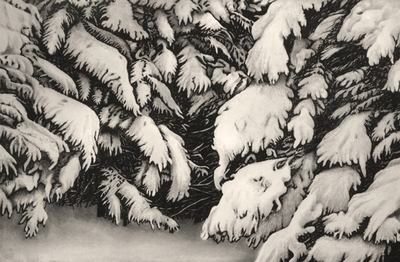Vaino Kola: Paintings
Vaino Kola, Deer Isle Suite #2, 2013, etching, 24 x 30″.
When the Finnish-born artist Vaino Kola was interviewed by Robert Brown for the Archives of American Art on September 12, 1991, he was living in Norton, MA. He was three years away from retiring from a distinguished quarter-century teaching career at Wheaton College and four from moving with his wife, ceramist Marcia Kola, to a new home on Deer Isle, ME. An admired painter and printmaker, he was known for potent political images and lyric landscapes, which had been shown widely.
The 12 pieces in this show span 35 or so years and overlap Kola’s New England residences. The earliest piece, Norton Woods II, an etching from 1980, highlights one of his signature subjects, snowbound trees, and his aesthetic when it comes to the natural world: a poetic realism. The subject is further developed in Deer Isle Suite, 2013, three winter etchings produced at the R.E. Townsend Studio in Georgetown, MA, and the haunting After the Snowfall #2, 2014, which could illustrate the opening scene in C.S. Lewis’s The Lion, The Witch and the Wardrobe.
Even where no snow is present, Kola’s landscapes have a cool quality, the palette tuned to northern hues. His renderings of the tidal coves and sea-smoothed granite ledges of the island on which he lives speak to a kind of geological purity, yet they are also studies in light. The sea in McNamara Cove #2, 2011–12, and Clammer Marks (Mud Flats), 2016, shimmers.
Kola is not prolific; he sometimes takes the better part of a year to complete one painting (they tend to be quite large). One imagines he learned some of his discipline—and patience—from the painter Beverly Hallam, who taught him at the Massachusetts College of Art, and Josef Albers, one of his teachers at Yale, both of them precisionists.
“In an often chaotic, violent, troubling world, there’s a clear need for art,” Kola told critic Kristen Andresen in a 2006 interview, adding, “It touches our soul, reminds us who we are and helps us regain our center.” His own work testifies to the truth of these words.

